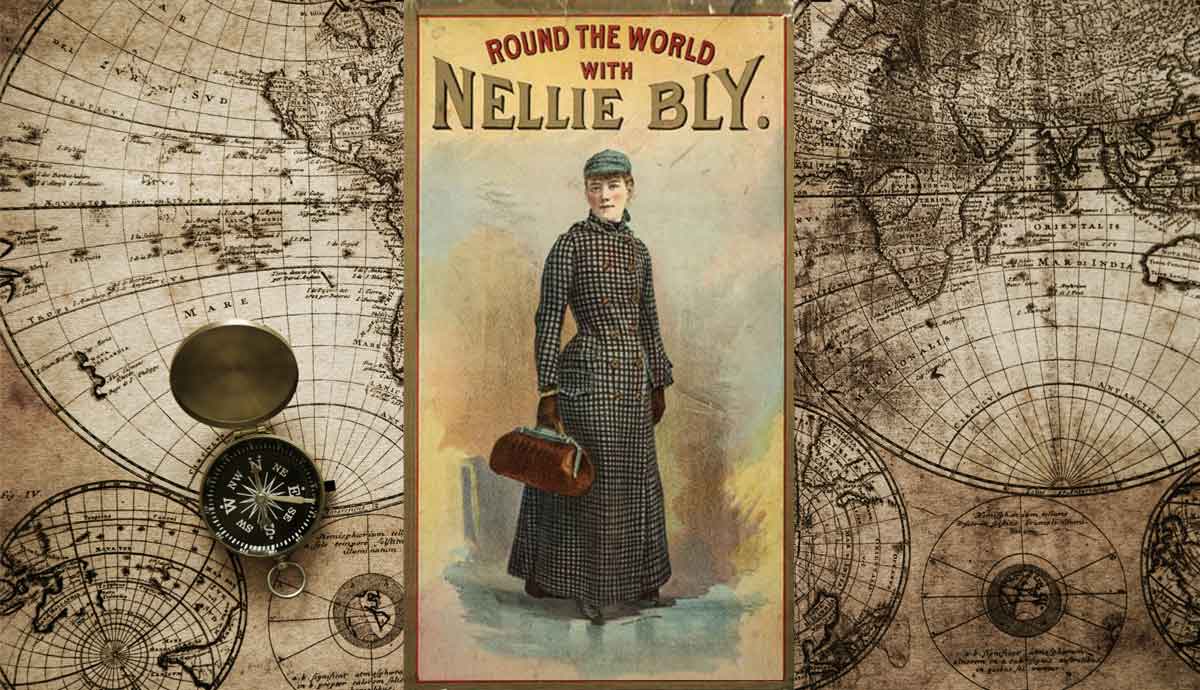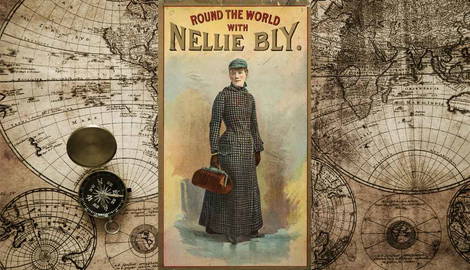
Formally named Elizabeth Jane Cochran, Nellie Bly was a determined young woman who became an influential investigative journalist. She sought out a career in journalism in the late 1800s, which was an uncommon position for a woman to hold at the time. Her tenacity allowed her to take on stories that exposed social issues and injustices. She’s also famously known for traveling around the world and reporting on her experiences. Bly is known as one of the influential figures that ushered in the era of investigative journalism, and her accomplishments proved her dedication to being a prominent journalist in history.
Early Life of Nellie Bly

Nellie Bly was born Elizabeth Jane Cochran on May 5, 1864. She spent her early childhood in Cochran’s Mill, Pennsylvania. Bly’s father was formerly married to another woman before he remarried Bly’s mother, Mary Jane Kennedy. Her father, Michael Cochran, had 10 children with his first wife and five children with Mary. Michael Cochran owned a local mill and a significant amount of land. He died when Nellie was six, and his fortune was split up between all of his children.
At the age of 15, Nellie attended the Indiana Normal School, which is now known as Indiana University of Pennsylvania. Bly was unable to continue her studies after one term because she couldn’t afford it. Due to financial issues caused by the death of Michael Cochran, Bly and her mother moved to Allegheny City, which is now the North Side of Pittsburgh, PA. Two of Bly’s older brothers settled in Pittsburgh as well. Bly struggled to find abundant work opportunities compared to her brothers.
Nellie Bly’s first opportunity to enter the journalism field was in 1885 when she anonymously responded to an article published in the Pittsburgh Dispatch titled “What Girls Are Good For.” The article outlined how women should be homemakers and criticized their involvement in the workforce. Under the pseudonym Lonely Orphan Girl, Bly sent a letter to the editor of the newspaper, George Madden, discussing her thoughts about how women should have more opportunities available to them. The editor was impressed with Bly’s letter. An ad was published in the newspaper shortly after, calling for the anonymous author to identify themselves.
The Beginning of Nellie Bly’s Investigative Journalism Career

Elizabeth Cochran adopted the pen name Nellie Bly when she started working for the Pittsburgh Dispatch. The editor was so impressed with her letter that she was hired as a reporter for a salary of five dollars per week. Like many women who worked in the male-dominated journalism industry, Bly was assigned to stories that only addressed women. Dissatisfied with her assignments, Bly left a note to the Pittsburgh Dispatch in 1886 stating that she was leaving because she had her sights set on New York City and warned to look out for her.
The following year, Bly went into The World newspaper office. The World was reestablished after Joseph Pulitzer assumed ownership. The first edition was published in May 1883. Despite being fairly new, The World was becoming one of the leading newspapers in the US. Bly pitched a story about the immigrant experience in America to Pulitzer, but it was declined. Pulitzer offered Bly an alternative. He wanted Bly to go undercover to investigate a notorious mental asylum in New York known as Blackwell’s Island. Bly quickly accepted the offer.
Nellie Bly Goes Undercover as a Mental Patient

To enter Blackwell’s Island, Bly had to figure out how to fake a mental illness. She detailed the steps she took to be submitted to the mental asylum in her exposé titled “Ten Days in a Mad-House.” The story was originally published as a series of articles in The World, and Bly later compiled the articles into a book. Nellie practiced looking insane in a mirror at her home by opening her eyes as wide as possible and staring without blinking. She detailed how she struggled with pretending to be insane, as she was unsure how she could fool everyone she would encounter since she had never been around an insane person before.
Bly admitted herself into the Temporary Home for Females for 30 cents a night under the name of Nellie Brown to begin her assignment. She acted sporadic and strange, which caused the other tenants and landlady to be convinced that she was insane. The police were called to take Bly away, and she was escorted to the Essex Market Police Courtroom. Bly had to convince the judge that she was insane to be sent to the asylum. She rambled on about losing her trunks and avoided questions about who she was or what brought her to New York.
After some questioning, Bly said that she was from Cuba but couldn’t remember the name of her home. She acted as if she had amnesia and made the judge think that she had been drugged and brought to the city by someone. After the judge was finished with questioning, he sent her to Bellevue Hospital to be examined further.
Investigating Blackwell’s Island Insane Asylum

Upon evaluation at the hospital, Bly was determined insane and sent to the Blackwell’s Island insane asylum. She was questioned by more doctors once she arrived. Every patient admitted to the asylum was asked if they heard voices or saw faces in the walls. Many patients denied having such hallucinations but were still considered insane. During Bly’s stay at Blackwell’s Island, she encountered very poor conditions. She also discovered that some of the patients there were actually quite sane.
Bly and other patients were given small meals, leaving them hungry. The asylum was cold, and workers blamed it on a rule that the heat couldn’t be turned on until October. The baths were also ice-cold, and Bly noted that the bath water wasn’t changed between each bathing of the patients. They only used one towel to dry each of the patients off. Patients were only bathed once a week, which was the only time they were able to use soap. The linens and clothing were swapped out just once a month. However, patients were changed into fresh clothing if they had a visitor to make it seem as though the asylum was under good management. Bly spent ten days and nights in the asylum, taking in as much information as she could about her experiences.

When Bly was released, she was summoned to appear before a grand jury as part of an investigation of Blackwell’s Island. Bly and the jurors were to visit the Island to witness its poor conditions for the investigation. One of the jurors informed Bly that the workers at the asylum were warned of their visit before they arrived. The stories between the doctors and nurses in the asylum were contradicting, and many of the poor conditions were blamed on a lack of funds to maintain the place.
One of the lead doctors at the asylum, Dr. Dent, claimed that he was unaware of the poor treatment of the patients and that the other doctors there weren’t competent. Once again, the excuse that the institution lacked proper funds to hire good medical personnel was used. Nellie Bly’s exposure of the poor conditions in the insane asylum resulted in New York City allocating an additional $1 million per year in funds for the care of the insane.
Nellie Bly Takes a Record-Breaking Trip Around the World

Nellie Bly’s next big feat came in 1889 when she approached her editor about taking a trip around the world in less than 80 days. Her idea for the trip was inspired by the recently published book Around the World in Eighty Days by French writer Jules Verne. The novel follows the fictional main character, Phileas Fogg, on his trip around the world. Bly’s editor proposed that a man go instead or have one escort Bly during her trip. Bly responded to this by stating she could start the trip at the same time as a man for another newspaper and beat him.
The editor later agreed to send Bly around the world after another writer announced that he was going to take the trip. Bly received the news that she was going to travel the world on November 12, 1889. She had only a few days to prepare and plan her adventure. She stuffed all that she could in a handbag. On November 14, Bly set off for the 28,000-mile trip. Her first of many stops was in London, England. When she arrived, she received a letter from Mr. and Mrs. Jules Verne to visit them at their home. Although it cut into Bly’s limited time, she agreed. While at the Verne residence, they expressed their excitement for Bly and her trip.

Nellie Bly traveled through many different countries and major cities along her way, including Port Said, Egypt; Penang, Malaysia; Singapore; Hong Kong, China; and San Francisco, US. She detailed her adventures in each location and noted her interactions with locals. She sent stories of her experiences back to The World throughout her trip. People back in the US quickly became interested in Nellie Bly and her fascinating stories from around the world.
Bly lost 15 days and 17 hours throughout her trip due to delays. She spent 56 days, 12 hours, and 41 minutes strictly on travel. On January 25, 1890, Nellie Bly completed her journey in Jersey City, New Jersey. It took her 72 days, 6 hours, and 11 minutes to circumnavigate the globe. Another woman journalist, Elizabeth Bisland, had taken on the challenge to travel around the world at the same time as Bly. Bisland finished her trip in 76 days. Nellie Bly broke the record for the fastest time traveling around the world and for the fastest time traveled between San Francisco and Chicago.
Nellie Bly Takes on New Adventures

Nellie Bly retired from her investigative journalism career after her marriage to industrialist millionaire Robert Seamen at 30 years of age. A decade after their courtship, Seamen died and left Bly his Ironclad Manufacturing Company. Bly was somewhat of a successful businesswoman, as she patented a number of inventions and provided her employees with a good work environment. However, she wasn’t as skilled in handling the finances of the business, which ultimately went bankrupt following charges of fraud brought upon the firm.
In 1911, Bly returned to investigate journalism and reported on the 1913 Woman Suffrage Parade in Washington DC. She also traveled to Europe to cover World War I on the Eastern Front. On January 27, 1922, Nellie Bly died due to pneumonia. Her determination and efforts to get a story through investigative reporting were recognized by some of the most well-known figures in the industry, such as American editor Arthur Brisbane.










